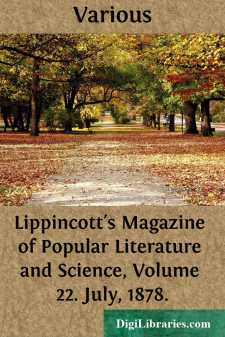Categories
- Antiques & Collectibles 13
- Architecture 36
- Art 48
- Bibles 22
- Biography & Autobiography 813
- Body, Mind & Spirit 142
- Business & Economics 28
- Children's Books 15
- Children's Fiction 12
- Computers 4
- Cooking 94
- Crafts & Hobbies 4
- Drama 346
- Education 46
- Family & Relationships 57
- Fiction 11828
- Games 19
- Gardening 17
- Health & Fitness 34
- History 1377
- House & Home 1
- Humor 147
- Juvenile Fiction 1873
- Juvenile Nonfiction 202
- Language Arts & Disciplines 88
- Law 16
- Literary Collections 686
- Literary Criticism 179
- Mathematics 13
- Medical 41
- Music 40
- Nature 179
- Non-Classifiable 1768
- Performing Arts 7
- Periodicals 1453
- Philosophy 64
- Photography 2
- Poetry 896
- Political Science 203
- Psychology 42
- Reference 154
- Religion 513
- Science 126
- Self-Help 84
- Social Science 81
- Sports & Recreation 34
- Study Aids 3
- Technology & Engineering 59
- Transportation 23
- Travel 463
- True Crime 29
Lippincott's Magazine of Popular Literature and Science, Volume 22. July, 1878.
by: Various
Description:
Excerpt
HERE AND THERE IN OLD BRISTOL.
GRAVE OF HANNAH MORE AT WRINGTON, NEAR BRISTOL.The streets of Bristol are, in a modern point of view, narrow and uninviting, yet if the visitor have a liking for the picturesque he will find much to interest him. There are plenty of streets crammed with old-time houses, thrusting out their upper stories beyond the lower, and with their many-gabled roofs seeming to heave and rock against the sky. If they lack anything in interest, it is that no local Scott has arisen to throw over them a glamour of romance which might make more tolerable the odors wherein they vie with the Canongate of sweet memory.
CHATTERTON AS DOORKEEPER IN COLSTON'S SCHOOL.Nor is the throng which fills the Bristol streets wholly prosaic in its aspect, for the quaint garb of ancient charities holds its own against the modern tailor. Such troops of charity-children taking their solemn walks! Such long lines of boys in corduroy, such streams of girls in pug bonnets, stuff gowns and white aprons, as pour forth from the schools and almshouses to be found in every quarter of the city! The Colston boys are less frequently seen, because the school has been removed to one of the suburbs, yet now and then one of their odd figures meets the eye. They wear a muffin cap of blue cloth with a yellow band around it and a yellow ball on its apex; a blue cloth coat with a long plaited skirt; a leathern belt, corduroy knee-breeches and yellow worsted stockings. Just such, in outside garb, was Chatterton a century ago, and thus he is represented on his monument near Redcliff church.
CHATTERTON CENOTAPH.You are perhaps gazing skyward at some lordly campanile when a sudden rush of feet and hum of voices comes around the corner, and the dark street is all aglow. These are the Red Maids, who walk the earth in scarlet gowns, set off by white aprons: they owe the bright hues of their existence to Alderman Whitson, who died in 1628, leaving funds to the mayor, burgesses and commonalty of the city of Bristol, "to the use and intent that they should therewith provide a fit and convenient dwelling-house for the abode of one grave, painful and modest woman of good life and conversation, and for forty poor women-children (whose parents, being freemen and burgesses of the said city, should be deceased or decayed); that they should therein admit the said woman and forty poor women-children, and cause them to be there kept and maintained, and also taught to read English and to sew and do some other laudable work toward their maintenance; ... and should cause every one of the said children to go and be apparelled in red cloth, and to give their attendance on the said woman, to attend and wait before the mayor and aldermen, their wives and others their associates, to hear sermons on the Sabbath and festival days, and other solemn meetings of the said mayor and aldermen and their wives," etc. etc. These maids are admitted between the ages of eight and ten, and at eighteen are placed at service.
Other aspects of Bristol are brought out in Pope's description of it in a letter to Mrs....












